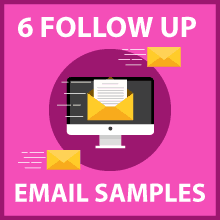 The road to a successful cold email campaign is hard. One of the trickiest obstacles to overcome is deciding on follow-up email samples to use after you get no response.
The road to a successful cold email campaign is hard. One of the trickiest obstacles to overcome is deciding on follow-up email samples to use after you get no response.
So you’ve built a B2B email list and started sending out your cold emails. Some people immediately return a reply, and some don’t.
How to approach writing a follow-up email that doesn’t suck?
Be fun or professional?
Should you follow up on your emails at all?
People on your B2B email list often won’t reply to the first message you send them, but that doesn’t make them a case closed.
It can happen for a variety of reasons. Maybe they were too busy for email on that day. Maybe they saw your message but forgot to reply. Maybe they were out of office (and didn’t set up an out of office message).
Maybe the pile of their unanswered emails got so out of hand that the single thought of opening Gmail makes them tremble with existential dread.
And maybe they are just not interested in your product — but even then you can turn naysayers around with a great follow-up.
Some recent studies have shown that if your first email remains unanswered, there’s still a 1-in-4 chance that a prospect replies to a follow-up. But according to Yesware, more than 70% of cold email campaigns stop after the first email.
Which means that if you’re not sending follow-up emails, you’re losing a sizable chunk of your business.
Still not convinced?
In 2014, Jason Zook of IWearYourShirt fame took a long hard look on over 2,000 deals he made via email and realized that more than 75% of them were made thanks to a follow-up email.
Let’s go over this again: there’s already a decent chance people will reply to your follow-ups, there’s an even better chance to close a deal after they reply, and most of your competition doesn’t do it.
The need to follow up on cold emails is indisputable.
But the proper way to do it? Not so much.
36 chambers of writing a great follow-up email
References to semi-obscure kung fu movies aside, writing a proper follow-up email requires utilizing the same tactics that you should use when writing an initial email.
Your email follow-up should be:
- Short
- Personal
- Fun
And most importantly, it should offer something of value.
Sound easy? You won’t believe how many people still send a follow-up wrong.
For example, here’s a message that I’ve received a couple of months back.
Would you care to answer it?
Probably not. I certainly didn’t. This message is harsh, it shames your prospect for being too busy with their own life and it doesn’t include their name or the name of the company that they are working for (which means that it’s probably a template).
This kind of a follow-up isn’t just a waste of the sender’s time — it actively wastes the prospect’s time, and that’s even worse.
If this looks similar to your approach to follow-ups… just stop sending them. And read on.
Let’s discuss in detail what makes a proper sales follow-up.
Should your follow-up stay in the same email thread?
There are two ways to send a follow-up:
- Send an email in the existing thread
- Send it as a new message
Some sales reps and marketers over-rely on the second approach, preferring to send each follow-up email as a separate message.
Although this method has its benefits (you have a better chance to capture the prospect’s attention) it can quickly become annoying. A separate follow-up email means that your prospect will have a harder time to understand what the message is about and which one they actually need to answer.
However, if you already sent several follow-up emails and still got no reply, trying one last time to get your prospect to reply isn’t a bad idea. Just make sure to start a new email thread only once.
Rethinking your approach to subject lines is a good idea as well. Chances are that the reason your recipient isn’t replying is because of a bland subject line of the original message. It's too easy to lose track of a message that's titled 'Hello'.
Coming up with an engaging subject line isn't hard. If you’re not sure where to start, read our guide to cold email subject lines and find a tip that will work for you.
A great follow-up is short
Nobody has the time to read through their email inbox.
If a person has already read your first email and decided not to reply, and you still make them read another huge message… Yeah, it won’t win you any new clients.
Besides, keep in mind the reason why you send a follow-up email in the first place — it’s not to sell your prospect on your product all over again, it’s to remind them about that initial message they didn’t reply to.
So let’s look at a great follow-up email sample after no response:
(Source: Reply)
It puts the most important information — time of the previous email — right in the very beginning of the message. It will help your prospect remember the reason for the follow-up email and the context of the original message.
This follow-up email sample runs just three sentences long (36 words to be exact). But it sounds enthusiastic and gives the recipient all the necessary information to remember why you’re following up in the first place. It’s pretty great.
Your follow-up email is personal — and fun
To return to that abysmal follow-up example that I mentioned a couple of paragraphs earlier — it’s actually pretty easy to mend its robotic, unnatural tone.
Just by mentioning the name of your prospect, their company and something that they actually did since the last time you’ve contacted them will work wonders for your follow-up strategy.
Context matters, by the way. A message that tells me ‘great job on your latest blog post’ can be speaking about an article I’ve done in 2014.
But if you put in an exact date, it means that you’ve done your homework:
A follow-up email like this instantly tells me that the sender cares about who I am and what I do, and that I should probably reward their approach with a reply.
Oh, and here’s another tip. Don’t hesitate to tell a joke — or maybe even turn your follow-up email into a fun little game. Here’s a stellar example:
(Source: RightHello)
Follow-up emails can be annoying by their very nature, so don’t be afraid to recognize that in a fun way.
Include a decision shortcut in your follow-up message
The previous follow-up email sample is great for another reason, it offers the recipient a shortcut to take. Let’s talk about that.
Having a shortcut to a quick reply (instead of a regular call-to-action) is a great strategy to utilize in your follow-up emails.
Here’s what it means.
People usually won’t reply to your message for one of two reasons:
- They are too busy
- They are not interested
When you write a follow-up, your main goal should be to understand which reason is the right one. Even if the reply is a brisk “Don’t message me again”, it’s a valid outcome. You can now spend that energy elsewhere.
So make it as simple as possible for people to reply by basically including their reply in your template.
Here’s how:
Ending with a question about the direction of the company will prompt your prospect to reply with a concrete yes or no: ‘yes, we decided on another strategy’, ‘no, we still want in’.
Offer something of value
Sometimes receiving a response will take up a few weeks. In that case, don’t be afraid to include something new in your next follow-up.
Maybe you published a new blog post on a relevant topic — or even released a new feature. Use it as a way to quietly shame your prospect into replying without being too aggressive about it.
After all, there’s a reason why I’ve been thinking about that prospect:
Just be sure not to come off as too needy (which means not explaining to a prospect for the fifth time in a row that you have a free trial).
Still trying to figure out where to get more leads?
Of course, the tips on this list won’t do you much good if you have no business contacts for your B2B email list. You can't send a follow-up without an initial email.
And you can’t send an email if you don’t have any leads.
Want better lead data? With LeadGibbon you can access over 20 million business contacts with verified email addresses and phone numbers, and export as many as you want in a single click. You can sign up for LeadGibbon here.
Conclusions
Writing a great follow-up email isn’t easy. Sometimes the urge to call it a day after the initial email is strong. Resist it!
Hopefully, some of the tips and examples above will be enough to improve your follow-ups. Just remember the most important thing about cold emails — you’re messaging real human beings and you should always respect their time.
Have a tip of your own? Share it in the comments!

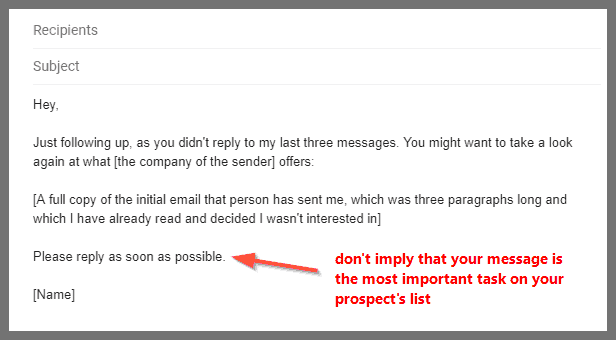
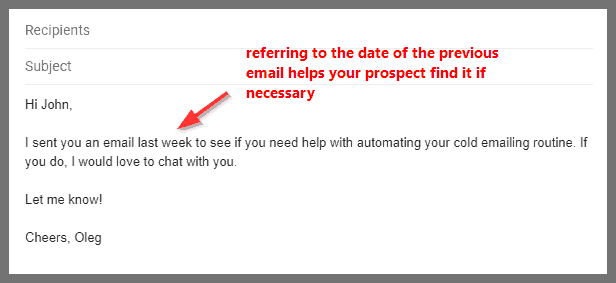

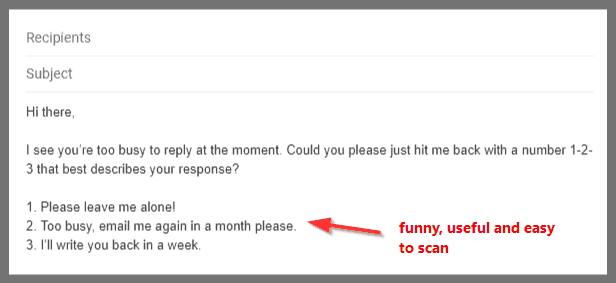
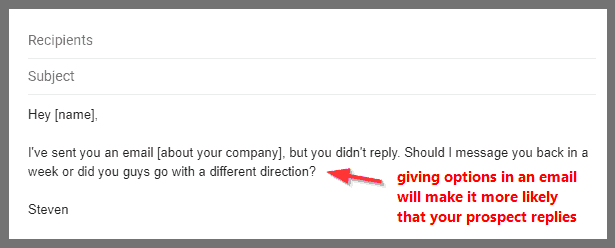
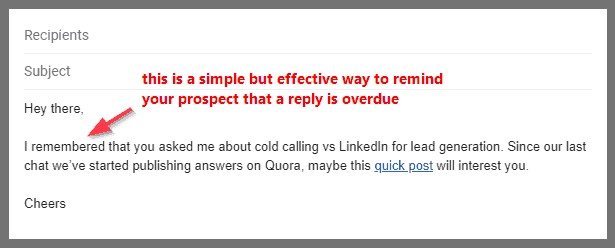
Hi
In July 2020 I have sent an email to the school assistant principal requesting for a letter of testimony as I have left the school in July 2020 too.
It was then the school summer break and she replied she will reply to me after coming back from the holidays at the end of July.
There was no reply from her and so I wrote a reminder to her in 2nd week of Aug 2020.
Still no reply from her and I did not follow up as school starts in third week of August and I thought she will be very busy and thought not to bother her then.
Until today still no reply. How do I continue to write a reminder email?
I hope she is more considerate of your time and efforts and responds to you! Good luck!?
hi i would like to ask, im about to send an email to my client to follow up regarding about the qoutation i sent him. Without sounding desperate and in hurry. Thank you.
how could i start an email with a client who asked me to contact in a months time and have not been replying to me emails(2) for last 20 days
Hi Vikas — can you explain a bit more about your situation? If your contact asked you to follow up in a month and you sent them two emails before the month was over, it was probably a mistake. People get too many emails and explicitly breaking your promise is rarely a good way to attract their attention. On the other hand, if a month has passed and your contact still isn’t replying, I’d send them one or two more follow up emails in a new email chain with a catchy subject line. If they ignore it, they are probably too busy for you anyway. If it’s a good contact you definitely want to convert, I’d try to reach out to them again in 3-6 months.
A great article with some fantastic points. When sending a follow up email regarding a sale or event, it’s imperative that the content is of value to the receiver. Time and planning is needed on occasion to hit the right tone for each person.
Great work on the examples, I found them useful.
Thanks for your comment, Vicky! I definitely agree that the content of the email should be of value, even if you’re sending follow-ups. That’s why it’s better to send a quick ‘hey, just following up’ message instead of repeating all of your points again, and even better to add some new information that the recipient will find useful (like mentioning a new feature you started to test since the last time you talked to the recipient).
Hi Steven,
You’ve made really good points in your article. I agree that follow-ups should be highly relevant and contextual. Nobody likes being nudged by some unknown person to answer a random email. A follow-up should bring additional value to a prospect. It can be a case study or a success story of a similar company who uses our product/service.
Mastering the art of writing follow-ups takes time and requires some effort, but it definitely pays off. We’ve recently done some research on the effectiveness of follow-ups at Woodpecker. We found out that a single follow-up can have a 40% higher reply rate in comparison to the initial email. The campaigns with as few as one follow-up email convert 22% more prospects than the ones without any follow-up email scheduled. Here’s a link to our study, if you’d like to learn more: https://bit.ly/2MEwFZS
How could I start an email to a professor that did not reply to my last email?
Very helpful information.